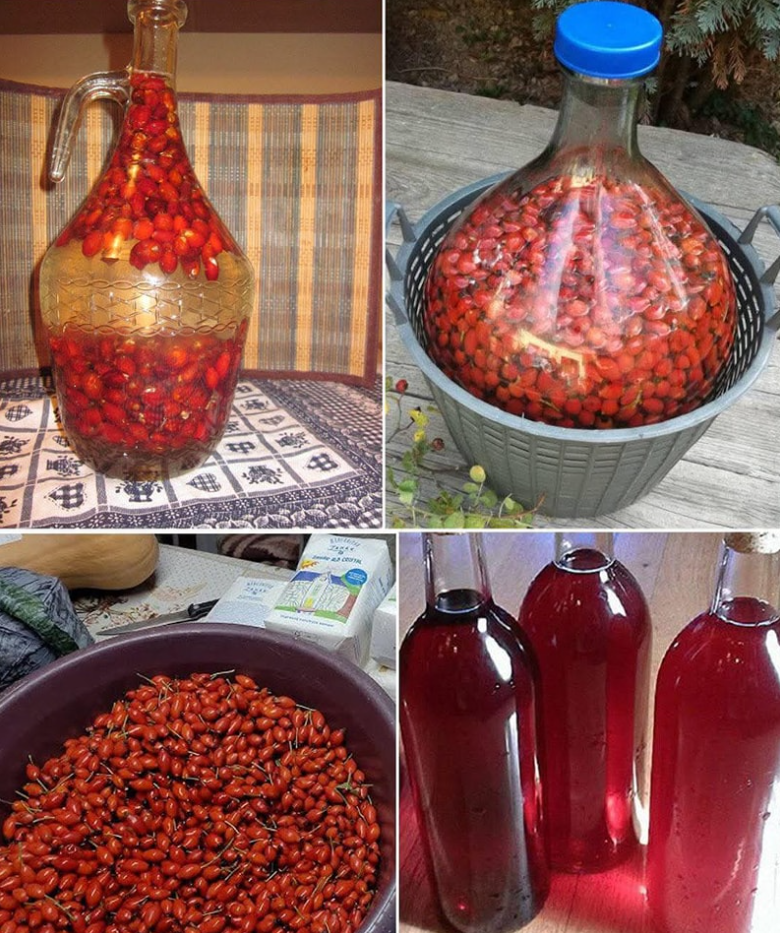-
1.5 kg (3.3 lbs) fresh or dried rosehips (ensure they are free from stems and seeds)
-
1.2 kg (2.6 lbs) granulated sugar
-
4 liters (1 gallon) boiled and cooled water
-
1 lemon (juice and zest)
-
1 orange (juice and zest)
-
1 tsp wine yeast (preferably for white wine)
-
1 tsp yeast nutrient
-
1 Campden tablet (optional, for sterilization)
-
1 tsp pectic enzyme (optional, helps with clarity)
Preparation:
-
Prepare the rosehips:
If using fresh rosehips, rinse them thoroughly and remove stems and blossom ends. Lightly crush the hips using a potato masher or food processor. Be careful not to pulverize the seeds — they can add bitterness. -
Sterilize equipment:
Use sterilized fermentation vessels and utensils to avoid contamination. If using a Campden tablet, dissolve it in the must and let it sit for 24 hours before adding the yeast. -
Combine ingredients:
Place the crushed rosehips into a primary fermentation bucket. Add the citrus juice and zest, followed by the sugar and boiled water. Stir until the sugar dissolves. -
Cool and add agents:
Once the mixture has cooled to room temperature, add the pectic enzyme (if using) and yeast nutrient. Cover loosely and let sit for 12 hours. -
Add yeast:
Sprinkle the wine yeast over the must and gently stir. Cover with a clean cloth or lid with an airlock, allowing fermentation gases to escape. -
Primary fermentation:
Let the mixture ferment for 5–7 days, stirring daily with a sterilized spoon. It should be bubbly and fragrant. -
Strain and transfer:
Strain the mixture through cheesecloth or a fine sieve into a demijohn or carboy, discarding solids. Fit with an airlock. -
Secondary fermentation:
Store in a cool, dark place for 4–6 weeks. The wine will begin to clarify. -
Racking and aging:
Once fermentation slows, rack the wine (transfer gently to a clean vessel, leaving sediment behind). Repeat racking every few months for clarity. Age for 6–12 months before bottling.
Serving and Storage Tips:
-
Serve chilled in small wine glasses as an aperitif or digestif.
-
Store bottles in a cool, dark cellar or cupboard; wine improves with age.
-
Once opened, refrigerate and consume within 5–7 days.
-
Use dark glass bottles to protect from light exposure.
Variants:
-
Rosehip & elderberry wine: Add 250 g elderberries for deeper color and flavor.
-
Spiced rosehip wine: Add a cinnamon stick and a few cloves during fermentation for a warm winter note.
-
Dry vs. sweet wine: Adjust sugar levels or stop fermentation early for a sweeter wine.
-
Herbal infusion twist: Infuse the must with chamomile or hibiscus petals for added aroma.
FAQ:
Q: Are rosehips safe to ferment and consume?
A: Yes, rosehips are edible and commonly used in teas, jams, and wine. Just avoid the seeds and hairs inside, which can be irritating.
Q: Can I use dried rosehips instead of fresh?
A: Absolutely. Rehydrate dried rosehips in warm water before crushing for the best extraction.
Q: How do I know when fermentation is complete?
A: Fermentation is complete when bubbling stops and the wine begins to clarify. A hydrometer can help confirm final gravity levels.
Q: Can I skip the pectic enzyme or Campden tablet?
A: Yes, but the wine may be cloudier, and the risk of contamination slightly increases. Many natural winemakers skip them with good results.
Q: Is rosehip wine alcoholic?
A: Yes, typically around 10–12% ABV depending on sugar content and fermentation length.
